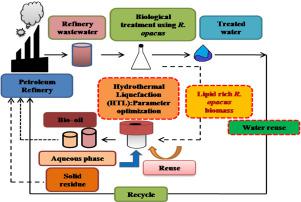Environmental Technology & Innovation ( IF 6.7 ) Pub Date : 2020-12-23 , DOI: 10.1016/j.eti.2020.101326 Tanushree Paul , Divya Baskaran , Kannan Pakshirajan , G. Pugazhenthi , Ravi Rajamanickam

|
In this research, a pure culture of Rhodococcus opacus strain PD630 was used to treat wastewater generated from a refinery and the lipid rich bacterial biomass obtained was converted to bio-oil. A very high removal (70 ± 5%) of organics present in the wastewater was achieved at pH 7 within 96 h along with lipid accumulation of 50 ± 4% by the bacteria. The lipid containing biomass procured by using the wastewater as the sole substrate was converted into bio-oil by hydrothermal liquefaction (HTL) technique. Different operational parameters viz. temperature, time and biomass/water ratio were optimized employing Response Surface Methodology (RSM) to achieve maximum bio-oil yield. The optimum conditions for maximum bio-oil yield (25.53%) were found to be 215 °C, 125 min and 0.25 biomass/water ratio; the bio-oil had a high heating value (HHV) of 20.73MJ/Kg, and it also contained a very low amount of water soluble products in it. GC–MS analysis of the obtained bio-oil product revealed the presence of a variety of compounds, mainly aldehydes, ketones and fatty acids, whereas the water soluble product contained mainly alcohols and phenolic compounds. Further analysis of the aqueous phase obtained as a byproduct concluded its potential for reuse owing to the presence of nutritional compounds. FTIR spectra of bio-oil revealed the presence of C–H bonds due to alkanes as the predominant functional group present in the product. FAME analysis results and other properties of the transesterified bio-oil matched well with the ASTM standard thus indicating its potential for bio-fuel application. This experimental study thus demonstrated that the lipid rich R. opacus biomass grown on cheaply available refinery wastewater is highly suited for potential bio-oil production.
中文翻译:

利用炼厂废水水热液化不透明红球菌生物质生产生物油:生物质平衡和工艺优化
在这项研究中,使用不透明红球菌PD630菌株的纯培养物处理炼油厂产生的废水,并将获得的富含脂质的细菌生物质转化为生物油。在pH值为7的情况下,在96小时内可将废水中的有机物去除率非常高(70±5%),而脂质的蓄积量则为50±4%通过细菌。通过水热液化(HTL)技术将废水作为唯一底物获得的含脂质生物质转化为生物油。不同的操作参数即。使用响应表面方法(RSM)优化温度,时间和生物质/水比,以实现最大的生物油产量。发现最大生物油产率(25.53%)的最佳条件是215°C,125分钟和0.25生物质/水比。该生物油具有20.73MJ / Kg的高热值(HHV),并且其中还包含非常少量的水溶性产物。对获得的生物油产品进行的GC-MS分析表明,存在多种化合物,主要是醛,酮和脂肪酸,而水溶性产品主要包含醇和酚类化合物。进一步分析作为副产物获得的水相,归因于存在营养化合物,因此有再利用的潜力。生物油的FTIR光谱显示,由于烷烃是产品中主要的官能团,因此存在C–H键。FAME分析结果和酯交换生物油的其他特性与ASTM标准非常吻合,因此表明其在生物燃料应用中的潜力。因此,该实验研究表明,富含脂质的在廉价的炼油厂废水中生长的不生红景天生物量非常适合潜在的生物油生产。











































 京公网安备 11010802027423号
京公网安备 11010802027423号